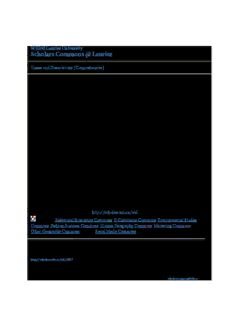
Understanding the Influencers of Second-Hand Apparel Shopping Behavior PDF
Preview Understanding the Influencers of Second-Hand Apparel Shopping Behavior
WWiillffrriidd LLaauurriieerr UUnniivveerrssiittyy SScchhoollaarrss CCoommmmoonnss @@ LLaauurriieerr Theses and Dissertations (Comprehensive) 2016 UUnnddeerrssttaannddiinngg tthhee IInnflfluueenncceerrss ooff SSeeccoonndd--HHaanndd AAppppaarreell SShhooppppiinngg BBeehhaavviioorr Robyn Hobbs Wilfrid Laurier University, [email protected] Follow this and additional works at: https://scholars.wlu.ca/etd Part of the Behavioral Economics Commons, E-Commerce Commons, Environmental Studies Commons, Fashion Business Commons, Human Geography Commons, Marketing Commons, Other Geography Commons, and the Social Media Commons RReeccoommmmeennddeedd CCiittaattiioonn Hobbs, Robyn, "Understanding the Influencers of Second-Hand Apparel Shopping Behavior" (2016). Theses and Dissertations (Comprehensive). 1887. https://scholars.wlu.ca/etd/1887 This Thesis is brought to you for free and open access by Scholars Commons @ Laurier. It has been accepted for inclusion in Theses and Dissertations (Comprehensive) by an authorized administrator of Scholars Commons @ Laurier. For more information, please contact [email protected]. Understanding the Influencers of Second-Hand Apparel Shopping Behavior By Robyn Hobbs Submitted in partial fulfillment for the requirements of the degree of Masters of Environmental Studies Wilfrid Laurier University 2016 Signed release form: NAME: Robyn Hobbs TITLE OF THESIS: Understanding the Influencers of Second-Hand Apparel Shopping Behavior DEGREE: Masters of Environmental Studies YEAR: 2016 This thesis becomes the property of Wilfrid Laurier University. The undersigned gives the University the right to permit the thesis to be consulted or borrowed as a regular part of the University holdings, and also to reproduce it in whole or in part in any form. SIGNATURE: DATE: September 20, 2016 Table of Contents 1. Abstract ....................................................................................................................... 5 2. Acknowledgments....................................................................................................... 6 3. Introduction ................................................................................................................. 6 3.1. Objectives ............................................................................................................. 8 4. Literature Review........................................................................................................ 8 4.1. Consumer decision-making theory and models ................................................... 8 4.1.1. Consumer Decision Making for Second-Hand Goods................................ 12 4.2. Factors Influencing the Decision Making Process ............................................. 13 4.2.1. Social Influence .......................................................................................... 15 4.2.2. Costs ............................................................................................................ 16 4.2.3. Influence of Recommendations .................................................................. 18 4.3. Second-Hand Retail - Resale and Purchasing Non-New Products .................... 19 4.3.1. Identified special factors influencing purchases ......................................... 20 4.3.2. Costs ............................................................................................................ 21 4.3.3. Social Influence .......................................................................................... 22 4.3.4. Trends ......................................................................................................... 23 4.3.5. Environmentally-Friendly ........................................................................... 26 4.4. Conclusion .......................................................................................................... 27 5. Methods..................................................................................................................... 28 5.1. Survey Instrument .............................................................................................. 29 5.2. Study Site and Population .................................................................................. 31 5.3. Sampling............................................................................................................. 33 5.4. Data Analysis Procedures................................................................................... 34 6. Results ....................................................................................................................... 37 6.1. Sample Characteristics ....................................................................................... 37 6.2. Second-Hand Apparel Shopping Behavior: Location, Duration, and Expenditures 42 6.3. Second-Hand Apparel Shopping Attitudes ........................................................ 45 6.4. Relationships between Shopping Behaviour, Attitudes and Socio-Demographics49 6.5. Unique Groupings of Second-Hand Shoppers ................................................... 63 7. Discussion & conclusion........................................................................................... 81 7.1. Summary of Results ........................................................................................... 81 7.2. Contribution to the Literature ............................................................................. 89 7.3. Implications for Retailers ................................................................................... 93 7.4. Theoretical Implications ..................................................................................... 96 7.5. Further Research & Limitations ......................................................................... 98 8. References ............................................................................................................... 102 9. Appendix ................................................................................................................. 108 List of Figures & Tables Figure 1 Consumer Decision Process EBM Model .......................................................... 10 Figure 2 Mental Accounting Theory Model ..................................................................... 11 Figure 3 Conceptual Matrix for Product Cues in Second-Hand Market .......................... 13 Figure 4 Survey Handout .................................................................................................. 30 Figure 5 Kitchener - Cambridge - Waterloo, Ontario Census Data .................................. 32 Figure 6 Study Locations for Surveys in the KW Region ................................................ 34 Figure 7 Conceptual Map of Process and Influencers for Second Hand Shopping .......... 98 Figure 8 Study Questionnaire ......................................................................................... 108 Table 1 Style by Category................................................................................................. 23 Table 2 KW Region Ethnic Groups, 2006 Census ........................................................... 31 Table 3 Variable Name Guide for Results ........................................................................ 35 Table 4 Socio-Demographic Characteristics of the Sample (n=157) ............................... 40 Table 5 Second-Hand Apparel Shopping Locations ......................................................... 43 Table 6 Hours Spent Second-Hand Apparel Shopping per Week by Location (In-store vs. Online) 44 Table 7 Expenditures for Second-Hand Apparel Shopping per Week by Location (In-store vs. Online) 44 Table 8 Second-Hand Apparel Shopping Attitudes, by Location (In-store Versus Online)47 Table 9 Correlation Values Between In Store Behaviors and Attitudes ........................... 52 Table 10 Correlation Values Between On-Line Behavioral and Attitude Variables ........ 59 Table 11 Correlation Values between Money Spent and Socio-Demographics ............... 62 Table 12 Hours Spent Second-Hand Apparel Shopping Per Week by Education Level and Household Income 63 Table 13 Money Spent Second-Hand Apparel Shopping Per Week by Personal Income and City of Residence 63 Table 14 Principal Component Matrix for Shopper’s Second-Hand Store Preferences ... 66 Table 15 Principal Component Matrix for Second-Hand Shopper’s Store Preferences, with added Socio-Demographics Variables ................................................................................................................................... 70 Table 16 Principal Component Matrix Groupings of In-Store Shopping Attitudes and Socio-Demographics 73 Table 17 Principal Component Matrix Groupings for Online Shopping Attitudes and Socio-Demographics 78 Table 18 Non-Response Observations by Random Sample n=91 .................................. 116 1. ABSTRACT Shopping for second-hand apparel is rapidly growing and has become a notable segment of the retail market. The purpose of this study is to determine what influences consumers when shopping second-hand for apparel products in-store and online. According to the existing literature, a number of key factors play significant roles for second-hand apparel shopping consumer decisions. They include: social, costs, trends and environmental influencers. Past research has not concentrated in-depth on the hedonistic and social influences of second-hand apparel shopping, financial factors, and time spent shopping for second-hand apparel. This study has observed the socio-demographic profile of second-hand shoppers, what location is preferred for shopping, and what influences them in their purchase decision-making. Quantitative research methods were used to observe consumer behavior, shopping attitudes both in- store and online, and socio-demographics. Surveys were conducted with 157 participants, in-person and online. The results of the study show the key factors which influence second-hand apparel shopping are social, economic, and environmental. The majority of shopping for second-hand apparel is in-store, more women are shopping than men and, perceived value and social influence are the key to what drives consumers to shop and purchase while income is not a key indicator. The findings of this study further our understanding of consumers of second-hand apparel, where they shop, and what influences them. This provides needed information to second-hand retailers to better tailor shopping environments.
Description: